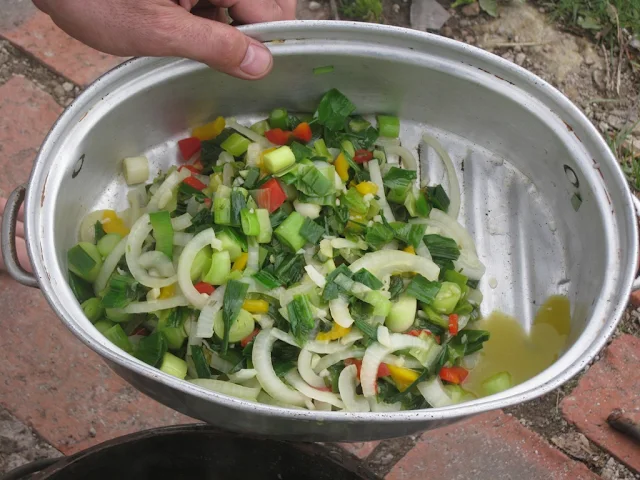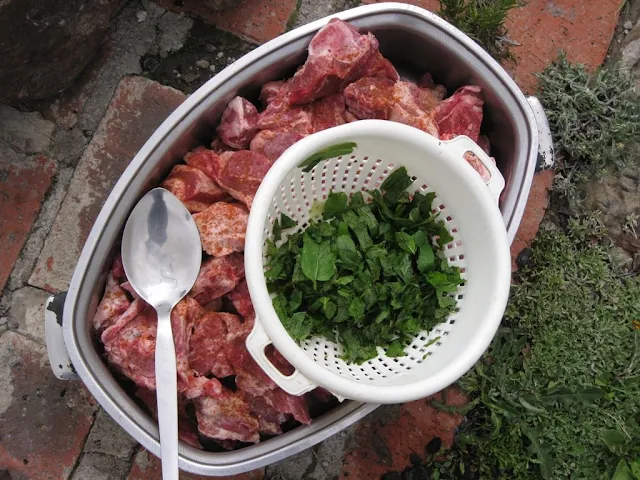Picture-Perfect Potjiekos
 |
| Potjie and Potjiekose in Lesotho |
Potjiekos (literally, pot-food) is perfect anywhere, but particularly in the beautiful, mountainous country of Lesotho, in which we were fortunate enough to spend a week in December. The grasslands were lovely, flush with the green of spring and new bulbs popping out in flower. But I digress. What does it take to make a potjie?
Potjiekos Recipe
1. Potjie pot (that's a black, three legged pot with a lid).
2. Coal fire (nicely died down, we're not talking an open fire here)
3. A couple of bricks (to keep wind from fire, if needed)
4. Vegetables: onions, garlic, red and green pepper, leeks, carrots and green beans, potatoes, pumpkins and summer squash
5. Meat - take your pick, here we used mutton
6. Spices - salt, pepper, barbeque spice
Do not forget:
A potjie-maker: (drum roll: one times huband)
Optional: a potjie helper
 |
| Potjie, potjiekos chef and potjiekos helper |
First things first. The pot needs to be heated, and heated well (if need be, scrubbing dirt, debris and spiders nests out before-hand):
 |
| Bring the oil to the boil in the potjie pot |
Once the oil is bubbling nicely, you can start to add your ingredients. First up, the garlic:
 |
| Add the garlic to the hot oil in the potjiekos pot |
Next, in go the leeks (including all their green leaves), the red and green pepper and onions. Use olive oil, as required. Drink beer - fires are thirst-making enterprises:
 |
| Leeks, green and red peppers, olive oil and beer: perfect for potjiekos perfection |
Stir the pot vigorously, better still, assign said stirring of pot to potjie helper:
 |
| The role of a potjiekos helper must never be under-estimated |
Check often (making sure your potjie helper is there to supervise):
 |
| Add vegetables to the pot |
Next, Remove softened vegetables from heat (and pot):
 |
| Remove softened vegetables from potjiekos pot |
 |
| Mutton for the potjiekos pot |
Heat up now empty pot, adding a bit of oil if needed before browning the meat to seal in the tenderness. (There should just be enough oil to stop the meat from sticking to the pot from previously softening the onions and garlic, etc., in the pot). After browning, leave to simmer rapidly for about 10 minutes before adding back the previously softened onions, garlic, leeks, red and green pepper, etc.
 |
| Cook the mutton well in the potjie pot |
 |
| Bubble, bubble in the potjie pot |
Once meat has achieved the required tenderness (or potjie helper starts hinting about being fed sometime today), check the fluid content and add a bit of water to cover meat, add the chopped up carrots and green beans, initially leaving them to steam as a layer on top.
 |
| Steam the greens in the potjiekos pot |
If you have time on your side, then the heat can be reduced and the vegetables steamed as a separate level on top. However, due to the demands of the potjie helper, I normally keep the heat up and stir the vegetables into the potjie, producing more of a stew than the traditional potjie that the hard-core brigade would consider to be appropriate.
If you are having PAP with the potjie, now is the time to put this on.
Gather the children around:
 |
| Gather the children around the potjiekos pot |
Add the potatoes and mint, this yet again I stir into the potjie, and keep cooking until the potatoes start breaking apart. Once this happens, the potato will start thickening the stew. Check liquid levels again, as there should be enough to steam the next course. the gravy does not need to cover the content, but there should be enough that you can see it bubbling.
 |
| Steam rising |
Finally, about 20 minutes before serving time, add the soft squashes and pumpkins, leave these on top to just steam, as stirring will just mush these up. Yet again, check liquid levels again to make sure there is enough liquid so it does not boil dry (add boiling water if needed), and put lid on. (Don't add any coals but let existing fire just die down over next 20 minutes)
If you are having RICE with the potjie, now is the time to put this on.
 |
| Add the squash |
Once the top layer is soft, potjie is ready to serve. If pap or rice needs a few more minutes, just leave the pot alone (with lid on) as by this stage the fire should have died down enough to just keep pot warm.
If you have added to much liquid and the potjie looks a bit watery, remove the lid to evaporate some water.
Eat, with relish!
 |
| Picture perfect potjiekos |
Can there be anything more picture-perfect than a potjie in Sehlabathebe National Park, Lesotho?


Comments
Post a Comment